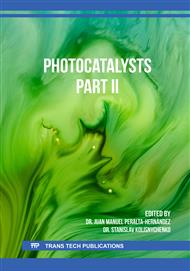[1]
C. Renz, Light reactions of the oxides of titanium, cerium and the earth acids, Helv. Chim. Acta. 4 (1921) 961–968.
Google Scholar
[2]
C.F. Goodeve, J.A. Kitchener, Photosensitisation by titanium dioxide, Trans. Faraday Soc. 34 (1938) 570–579.
DOI: 10.1039/tf9383400570
Google Scholar
[3]
V.D. Binas, K. Sambani, T. Maggos, A. Katsanaki, G. Kiriakidis, Synthesis and photocatalytic activity of Mn-doped TiO2 nanostructured powders under UV and visible light, Appl. Catal. B Environ. 113–114 (2012) 79–86.
DOI: 10.1016/j.apcatb.2011.11.021
Google Scholar
[4]
J.C. Lin, K. Sopajaree, T. Jitjanesuwan, M. Lu, Application of visible light on copper-doped titanium dioxide catalyzing degradation of chlorophenols, Sep. Purif. Technol. 191 (2018) 233–243.
DOI: 10.1016/j.seppur.2017.09.027
Google Scholar
[5]
P. Singla, O.P. Pandey, K. Singh, Study of photocatalytic degradation of environmentally harmful phthalate esters using Ni-doped TiO2 nanoparticles, Int. J. Environ. Sci. Technol. 13 (2016) 849–856.
DOI: 10.1007/s13762-015-0909-8
Google Scholar
[6]
Y. Matsumoto, M. Katayama, T. Abe, T. Ohsawa, I. Ohkubo, H. Kumigashira, M. Oshima, H. Koinuma, Chemical trend of Fermi-level shift in transition metal-doped TiO2 films, J. Ceram. Soc. Japan. 2 (2010) 993–996.
DOI: 10.2109/jcersj2.118.993
Google Scholar
[7]
F. Huang, A. Yan, H. Zhao, Influences of Doping on Photocatalytic Properties of TiO2 Photocatalyst, in: Semicond. Photocatal. - Mater. Mech. Appl., InTech, 2013: p.75–100.
Google Scholar
[8]
N. Nishiyama, Y. Fujiwara, K. Adachi, K. Inumaru, S. Yamazaki, Preparation of porous metal-ion-doped titanium dioxide and the photocatalytic degradation of 4-chlorophenol under visible light irradiation, Appl. Catal. B Environ. 176–177 (2015) 347–353.
DOI: 10.1016/j.apcatb.2015.04.015
Google Scholar
[9]
G. Li, A. Bono, D. Krishnaiah, J.G. Collin, Preparation of titanium dioxide photocatalyst loaded onto activated carbon support using chemical vapor deposition : A review paper, J. Hazard. Mater. 157 (2008) 209–219.
DOI: 10.1016/j.jhazmat.2008.01.040
Google Scholar
[10]
N. Liu, X. Chen, J. Zhang, J.W. Schwank, A review on TiO2-based nanotubes synthesized via hydrothermal method: Formation mechanism, structure modification, and photocatalytic applications, Catal. Today. 225 (2014) 34–51.
DOI: 10.1016/j.cattod.2013.10.090
Google Scholar
[11]
P. Gross, S.N. Pronkin, T. Cottineau, B. Nicolas, N. Keller, E.R. Savinova, One step synthesis of niobium doped titania nanotube arrays to form (N, Nb) co-doped TiO2 with high visible light photoelectrochemical activity, J. Mater. Chem. A Mater. Energy Sustain. (2013) 2151–2160.
DOI: 10.1039/c2ta00922f
Google Scholar
[12]
Z.B. Xie, D.J. Blackwood, Effects of anodization parameters on the formation of titania nanotubes in ethylene glycol, Electrochim. Acta. 56 (2010) 905–912.
DOI: 10.1016/j.electacta.2010.10.004
Google Scholar
[13]
J.V. Pasikhani, N. Gilani, A.E. Pirbazari, The effect of the anodization voltage on the geometrical characteristics and photocatalytic activity of TiO2 nanotube arrays, Nano-Structures and Nano-Objects. 8 (2016) 7–14.
DOI: 10.1016/j.nanoso.2016.09.001
Google Scholar
[14]
T. Hoseinzadeh, Z. Ghorannevis, M. Ghoranneviss, A.H. Sari, M.K. Salem, Effects of various applied voltages on physical properties of TiO2 nanotubes by anodization method, J. Theor. Appl. Phys. 11 (2017) 243–248.
DOI: 10.1007/s40094-017-0257-9
Google Scholar
[15]
J. Chen, H. Wang, X. Wei, L. Zhu, Characterization, properties and catalytic application of TiO2 nanotubes prepared by ultrasonic-assisted sol-hydrothermal method, Mater. Res. Bull. 47 (2012) 3747–3752.
DOI: 10.1016/j.materresbull.2012.06.029
Google Scholar
[16]
T. Luttrell, S. Halpegamage, J. Tao, A. Kramer, E. Sutter, M. Batzill, Why is anatase a better photocatalyst than rutile? - Model studies on epitaxial TiO2 films, Sci. Rep. 4 (2015) 1–8.
DOI: 10.1038/srep04043
Google Scholar
[17]
S.I. Mogal, V.G. Gandhi, M. Mishra, S. Tripathi, T. Shripathi, P.A. Joshi, D.O. Shah, Single-step synthesis of silver-doped titanium dioxide: Influence of silver on structural, textural, and photocatalytic properties, Ind. Eng. Chem. Res. 53 (2014) 5749–5758.
DOI: 10.1021/ie404230q
Google Scholar
[18]
A. Burns, G. Hayes, W. Li, J. Hirvonen, J.D. Demaree, S.I. Shah, Neodymium ion dopant effects on the phase transformation in sol-gel derived titania nanostructures, Mater. Sci. Eng. B Solid-State Mater. Adv. Technol. 111 (2004) 150–155.
DOI: 10.1016/j.mseb.2004.04.008
Google Scholar
[19]
Y.L. Pang, S. Lim, H.C. Ong, W.T. Chong, A critical review on the recent progress of synthesizing techniques and fabrication of TiO2-based nanotubes photocatalysts, Appl. Catal. A Gen. 481 (2014) 127–142.
DOI: 10.1016/j.apcata.2014.05.007
Google Scholar
[20]
S. Muniyappan, T. Solaiyammal, K. Sudhakar, A. Karthigeyan, P. Murugakoothan, Conventional hydrothermal synthesis of titanate nanotubes: Systematic discussions on structural, optical, thermal and morphological properties, Mod. Electron. Mater. 3 (2017) 174–178.
DOI: 10.1016/j.moem.2017.10.002
Google Scholar
[21]
L. Cui, K.N. Hui, K.S. Hui, S.K. Lee, W. Zhou, Z.P. Wan, C.N.H. Thuc, Facile microwave-assisted hydrothermal synthesis of TiO2 nanotubes, Mater. Lett. 75 (2012) 175–178.
DOI: 10.1016/j.matlet.2012.02.004
Google Scholar
[22]
B. Liu, X. Zhao, C. Terashima, A. Fujishima, K. Nakata, Thermodynamic and kinetic analysis of heterogeneous photocatalysis for semiconductor systems, Phys. Chem. Chem. Phys. 16 (2014) 8751.
DOI: 10.1039/c3cp55317e
Google Scholar
[23]
A. Houas, H. Lachheb, M. Ksibi, E. Elaloui, C. Guillard, J.M. Herrmann, Photocatalytic degradation pathway of methylene blue in water, Appl. Catal. B Environ. 31 (2001) 145–157.
DOI: 10.1016/s0926-3373(00)00276-9
Google Scholar
[24]
P. Roy, S. Berger, P. Schmuki, TiO2 Nanotubes: Synthesis and applications, Angew. Chemie. 50 (2011) 2904–2939.
DOI: 10.1002/anie.201001374
Google Scholar
[25]
S. Kment, H. Kmentova, P. Kluson, J. Krysa, Z. Hubicka, V. Cirkva, I. Gregora, O. Solcova, L. Jastrabik, Notes on the photo-induced characteristics of transition metal-doped and undoped titanium dioxide thin films, J. Colloid Interface Sci. 348 (2010) 198–205.
DOI: 10.1016/j.jcis.2010.04.002
Google Scholar
[26]
D. Cao, Y. Wang, X. Zhao, Combination of photocatalytic and electrochemical degradation of organic pollutants from water, Curr. Opin. Green Sustain. Chem. 6 (2017) 78–84.
Google Scholar



